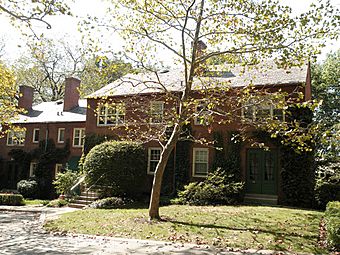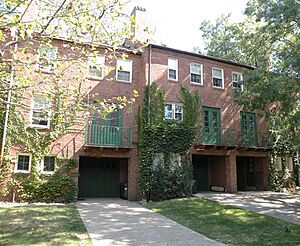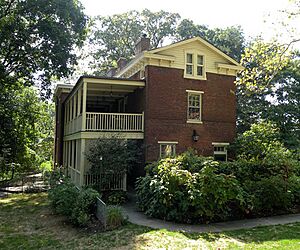Chatham Village (Pittsburgh) facts for kids
|
Chatham Village Historic District
|
|

Some houses in the Chatham Village Historic District
|
|
| Location | Roughly bounded by Virginia Ave., Bigham St., Woodruff St., Saw Mill Run Blvd., and Olympia Rd., Pittsburgh, Pennsylvania |
|---|---|
| Area | 46 acres (19 ha) |
| Built | 1932 to 1936 |
| Architect | Clarence Stein and Henry Wright |
| Architectural style | Georgian Colonial Revival, Classical Revival |
| NRHP reference No. | 98001372 |
Quick facts for kids Significant dates |
|
| Added to NRHP | November 25, 1998 |
| Designated NHLD | April 5, 2005 |
Chatham Village is a special neighborhood in Pittsburgh, Pennsylvania. It's part of the larger Mount Washington area. This community is known around the world for its great design.
It is located near Virginia Avenue, Bigham Street, Woodruff Street, Saw Mill Run Boulevard, and Olympia Road. In 2005, Chatham Village was named a National Historic Landmark. This means it's a very important place in American history. It's a great example of the "Garden City Movement" style. The people who live in Chatham Village own and manage it together.
Contents
History of Chatham Village
Chatham Village was built between 1932 and 1936. It was designed by two famous architects, Clarence Stein and Henry Wright. They used ideas from the Garden City Movement. This movement aimed to create communities with lots of green spaces and a good plan.
The homes are built in the Georgian Colonial Revival style. This is a classic look with red brick and traditional designs. The village was first built to show that nice, safe homes could be affordable for working families. However, because it was so attractive, it quickly became a popular place for middle and upper-class families. The money to build Chatham Village came from Pittsburgh's Buhl Foundation.
Why Chatham Village Is Important
In 2007, Chatham Village was named one of the "Great Neighborhoods" in America. This was part of a program by the American Planning Association. They recognized it for its good design, how well it works, its long-term health, and how involved the community is.
A writer named Jane Jacobs wrote about Chatham Village in her book, The Death and Life of Great American Cities. She thought that while places like Chatham Village were nice, they sometimes created groups of people who were all very similar. This could make it harder for people from different backgrounds to connect in a city. She believed that the success of Chatham Village was partly because its residents had similar jobs and social lives. She argued that the "Garden City" ideas might work best for certain lifestyles, but not always for the many different kinds of people in a big city.
The Homes in Chatham Village
The homes in Chatham Village are townhouses made of red brick with slate roofs. They are grouped together around shared courtyards. The back of the homes face the loop roads that go around the property.
Many homes have garages built into their basements. These garages are set back a few feet from the street. This design helps to make the garages less noticeable from the road. City planners, architects, and landscape designers see Chatham Village as one of the best examples of the Garden City idea. It is also a National Historic Landmark and is listed on the National Register of Historic Places. It's also recognized by the Pittsburgh History and Landmarks Foundation.
Chatham Hall Community Building
The Chatham Village community has a special building called Chatham Hall. This building was originally the Bigham House, built in 1849. It was once the home of Thomas Bigham.
Thomas James Bigham (1810–1884) was an abolitionist lawyer. An abolitionist was someone who worked to end slavery. It is said that his house was a "station" on the Underground Railroad. The Underground Railroad was a secret network that helped enslaved people find freedom. Today, the Bigham House has been updated and is used as a clubhouse for the Chatham Village community.
Gallery
- Chatham Village Website [1]











